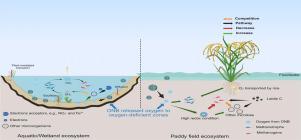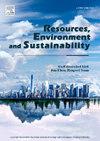Interfacial oxygen nanobubble for mitigating the methane emissions from aquatic ecosystems: A review
IF 7.8
Q1 ENVIRONMENTAL SCIENCES
引用次数: 0
Abstract
Methane (CH4) emissions from aquatic ecosystems, including wetlands, freshwater bodies, and rice paddies, contribute significantly to global warming due to CH4’s high global warming potential. Traditional CH4 mitigation strategies, such as mechanical aeration, sediment capping, and vegetation management, face challenges related to high costs, inefficiency in oxygen delivery, and ecological disturbances. In recent years, interfacial oxygen nanobubbles (IONBs) have emerged as a promising geoengineering solution for reducing CH4 emissions by providing sustained oxygenation in anoxic sediments. Unlike conventional methods, IONBs exhibit high stability, prolonged oxygen retention, and slow, controlled oxygen release, reducing the need for frequent re-application. This sustained oxygenation creates long-lasting aerobic microenvironments that suppress methanogenesis while stimulating methanotrophic CH4 oxidation. Furthermore, IONB-loaded carriers, such as biochars and zeolites, enable targeted oxygenation, improving redox conditions and promoting beneficial microbial shifts. Compared to mechanical aeration, which rapidly dissipates oxygen, or chemical amendments requiring repeated treatments, IONBs provide a low-maintenance, cost-effective alternative with minimal ecological disruption. This review explores the physicochemical properties of IONBs, their mechanisms of action in altering sedimentary biogeochemical processes, and their potential applications in mitigating CH4 flux from different aquatic ecosystems. Despite their potential, challenges remain in optimizing oxygen-loading capacity, assessing long-term ecological impacts, and scaling up production. Future research should focus on refining the oxygen-loading capacity of IONBs, integrating them with existing mitigation approaches, and evaluating their role in global climate policies. As an innovative and sustainable tool, IONBs hold great promise for advancing wetland conservation, reducing agricultural CH4 emissions, and climate change mitigation efforts.

界面氧纳米泡减少水生生态系统甲烷排放的研究进展
湿地、淡水水体和稻田等水生生态系统的甲烷(CH4)排放具有较高的全球变暖潜势,对全球变暖有重要贡献。传统的CH4缓解策略,如机械曝气、沉积物封顶和植被管理,面临着与成本高、氧气输送效率低和生态干扰相关的挑战。近年来,界面氧纳米气泡(IONBs)已成为一种有前途的地球工程解决方案,通过在缺氧沉积物中提供持续的氧化来减少CH4的排放。与传统方法不同,ionb具有高稳定性、长时间的氧保留和缓慢、可控的氧释放,减少了频繁重新应用的需要。这种持续的氧化创造了持久的有氧微环境,抑制甲烷生成,同时刺激甲烷营养化CH4氧化。此外,离子b负载载体,如生物炭和沸石,可以实现靶向氧化,改善氧化还原条件,促进有益微生物的转移。与快速耗散氧气的机械曝气或需要重复处理的化学修正相比,ionb提供了一种维护成本低、成本效益高的替代方案,对生态的破坏最小。本文综述了ionb的物理化学性质、改变沉积生物地球化学过程的作用机制及其在减少不同水生生态系统CH4通量方面的潜在应用。尽管具有潜力,但在优化氧负荷能力、评估长期生态影响和扩大生产方面仍存在挑战。未来的研究应侧重于改进ionb的载氧能力,将其与现有的减缓方法相结合,并评估其在全球气候政策中的作用。作为一种创新和可持续的工具,ionb在促进湿地保护、减少农业甲烷排放和减缓气候变化方面前景广阔。
本文章由计算机程序翻译,如有差异,请以英文原文为准。
求助全文
约1分钟内获得全文
求助全文
来源期刊

Resources Environment and Sustainability
Environmental Science-Environmental Science (miscellaneous)
CiteScore
15.10
自引率
0.00%
发文量
41
审稿时长
33 days
 求助内容:
求助内容: 应助结果提醒方式:
应助结果提醒方式:


